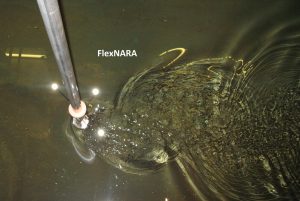VIV of long flexible cylindrical structures such as marine risers, subsea pipelines, power cables, mooring lines & tethers exhibits several interesting fluid-structure interaction phenomena (e.g. dual resonances, hysteresis, higher harmonics, mode switching, mode sharing, traveling wave, drag amplification). When exposed to ocean flows, these slender bodies undergo nonlinear large-amplitude oscillation due to the space-time varying hydrodynamics associated with vortex shedding. Because VIV results in an increased mean drag and high oscillating stress-induced fatigue in long flexible structures, VIV is one of the utmost concerns in deepwater developments.
FlexNARA team has been developing computationally efficient models and analysis tools which have been used to examine a variety of VIV phenomena associated with combined hydrodynamics and structural geometric nonlinearities, see our publications. We have developed an experimental framework as below and combined analytical-numerical approaches to deal with several VIV problems.



